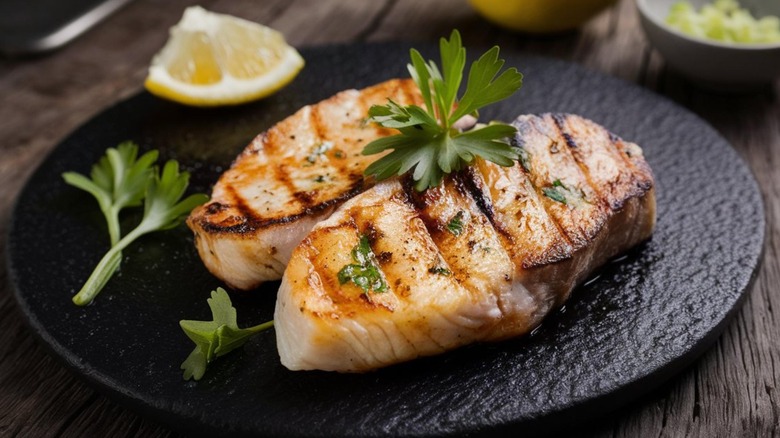How To Cook The Most Flavorful Swordfish On The Grill
We may receive a commission on purchases made from links.
Even for die-hard meat-eaters, a grilled swordfish steak can be irresistible. Like a beef steak, swordfish retains its firm, meaty texture and juiciness when seared at high heat. Despite its similarities, though, swordfish shouldn't be cooked the same way as beef, and so we sought advice from Sheila Lucero, the culinary director at Big Red F Restaurant Group and the executive chef at Jax Fish House & Oyster Bar and Centro Mexican Kitchen. "Swordfish is ideal for grilling and marinades," Lucero told Tasting Table. "It is lean and firm, allowing it to take on a nice marinade." Chefs have a few essential rules about how to marinate seafood, and for swordfish, a marinade should have oil and an acid, like lemon juice or red wine vinegar, paired with bold, assertive aromatics and herbs like garlic, oregano, or rosemary.
However, one of the biggest mistakes when marinating seafood is leaving the fish soaking in the marinade too long. "Over-marinating can start to break down the filet, resulting in a mushy texture," Lucero said. "Keep it quick, 15 to 20 minutes is plenty ... Over marinating can start to break down the filet, resulting in a mushy texture. Its firm texture allows for easier turning and flipping on the grill." Lucero prefers cooking swordfish over direct high heat, so to prevent it from falling apart, have the fish monger cut it into steaks about one-and-one-half-inches thick, or buy a large piece and cut it yourself into steaks.
An expert's tips for perfectly grilled swordfish
Swordfish can grow up to nearly 1,200 pounds, and although smaller swordfish are generally caught in fisheries, they are not always delivered whole to a fish market, which means they may not be as freshly caught as you want. When selecting swordfish steaks, look for flesh that's pink or cream-colored, and as Julia Child advised, don't be shy about asking to sniff it. Fresh fish shouldn't smell overly fishy but should have a pleasant ocean scent instead.
Before grilling your marinated swordfish, massage both sides of the steak with oil, which will prevent it from sticking to the grill, and sear the steak for about five minutes on each side. "When swordfish is done, it changes from translucent to opaque," Lucero advised. "Look at the sides of the fish to check for this change." In addition, she advised testing the swordfish's texture by pressing its center with your finger or a fork. "It should feel firm but still slightly springy," the chef said.
Lucero recommends using a meat thermometer to ensure that the swordfish is done, and although the USDA recommends cooking fish to an internal temperature of 145 degrees Fahrenheit, she prefers "to cook [the] swordfish to 130 to 135 [degrees Fahrenheit] and remove it from the grill to carry over." This method of slightly undercooking food on a grill allows the carryover heat to finish the swordfish and keep it juicy.

